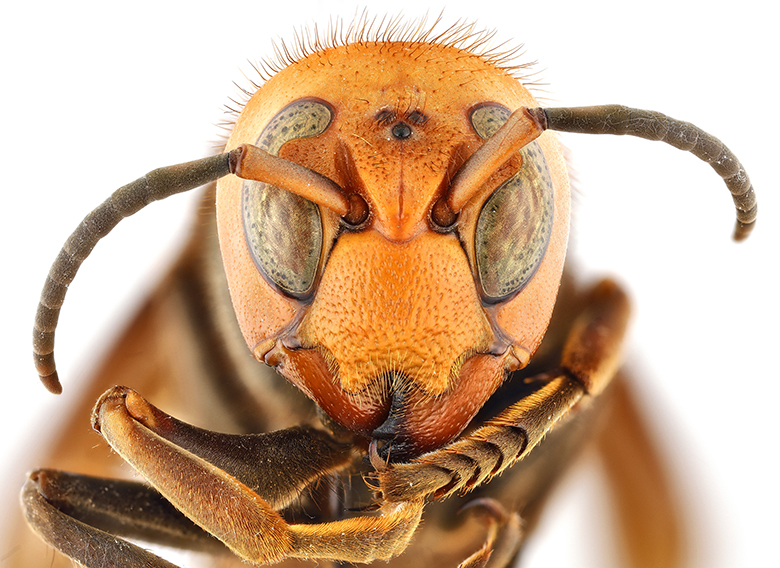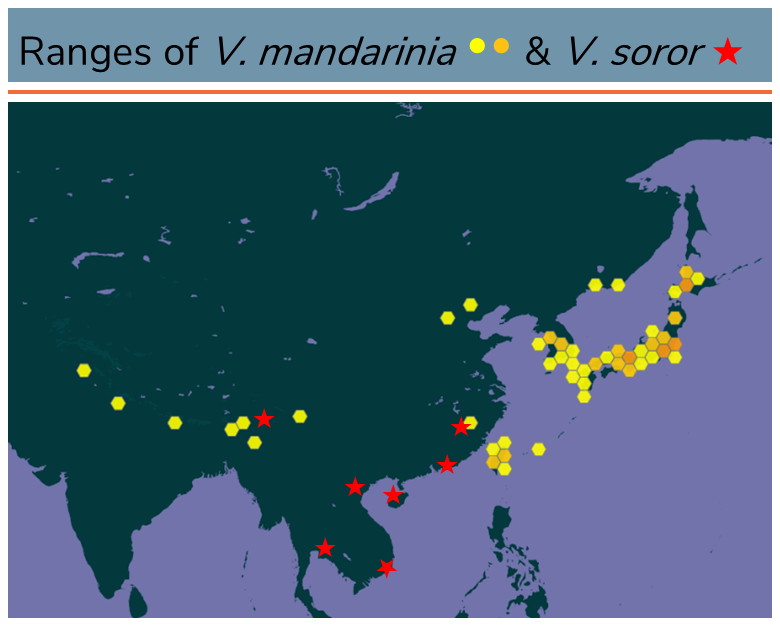Invasive hornet found in more northerly range among related species in Asia

Annapolis, MD; July 25, 2022—The Entomological Society of America has adopted "northern giant hornet" for the species Vespa mandarinia in its Common Names of Insects and Related Organisms List.
Vespa mandarinia is an invasive hornet native to Asia that has been the target of eradication efforts in Washington state, USA, and British Columbia, Canada, after individual hornets were first discovered there in 2019. It has been referred to elsewhere as "Asian giant hornet" or "murder hornet."
In conjunction with "northern giant hornet," ESA has also adopted "southern giant hornet" as the common name for the species Vespa soror and "yellow-legged hornet" for Vespa velutina. Vespa soror is a closely related—and similarly large—species to V. mandarinia, and the descriptors "northern" and "southern" refer to the species' native geographic ranges in Asia.
"Common names are an important tool for entomologists to communicate with the public about insects and insect science," says ESA President Jessica Ware, Ph.D. "Northern giant hornet is both scientifically accurate and easy to understand, and it avoids evoking fear or discrimination."

(Range map by Gard W. Otis, Ph.D., University of Guelph; location data from Global Biodiversity Information Facility, gbif.org)
In 2021, ESA adopted new guidelines for acceptable insect common names, which bar names referring to ethnic or racial groups and names that might stoke fear; the policies also discourage geographic references, particularly for invasive species. The Society also launched the Better Common Names Project, an effort to review and replace insect common names that may be inappropriate or offensive. No common name for Vespa mandarinia has been previously adopted by ESA, and neither name used in popular discourse meets ESA's guidelines.
Entomologist Chris Looney, Ph.D., who is part of the Washington State Department of Agriculture team researching and attempting to eradicate the hornet, authored the common-name proposal submitted to ESA, citing the need for an accessible, accurate name to facilitate simple and inclusive public communication about the insect.
Amid a rise in hate crimes and discrimination against people of Asian descent, usage of "Asian" in the name of a pest insect can unintentionally bolster anti-Asian sentiment. And, from a taxonomic perspective, all hornets—22 species of wasps in the genus Vespa—are native or common to Asia, meaning "Asian giant hornet" does not convey unique information about the biology or behavior of the species Vespa mandarinia.
"ESA is grateful to Dr. Looney for proposing this common name," Ware says. "And we commend the entomologists and colleagues on both sides of the border for their energy and ingenuity in working to prevent the northern giant hornet from gaining a foothold in North America."
While confirmed sightings have been confined to a single county in Washington and several locations in southern British Columbia, the northern giant hornet could likely find suitable habitat in much of the Pacific Northwest region and beyond if allowed to disperse. It would pose a significant threat to native bees and honey bees, which lack natural defenses against the hornet. How the hornets arrived in North America remains under investigation, though DNA analysis shows hornets on each side of the U.S./Canada border likely did not come from the same location in Asia, suggesting the possibility of more than one introduction.
In all future communications—including its research journals, blog, website, and social media—ESA will adopt "northern giant hornet" in reference to Vespa mandarinia, and the Society urges the scientific community, media, government agencies, and the public to transition to use of "northern giant hornet" in their own communications as time and resources allow.
The Entomological Society of Canada has also approved "northern giant hornet" (and "frelon géant du nord" in French) for Vespa mandarinia and "southern giant hornet" ("frelon géant du sud" in French) for Vespa soror in its common names list.
For further information—including additional background, sample text, and FAQs—see ESA's Northern Giant Hornet Common Name Toolkit.
And, for more info about detection and eradication efforts in Washington state and British Columbia, see the following resources:
###
CONTACT: Joe Rominiecki, jrominiecki@entsoc.org, 301-731-4535 x3009
ABOUT: ESA is the largest organization in the world serving the professional and scientific needs of entomologists and people in related disciplines. Founded in 1889, ESA today has more than 7,000 members affiliated with educational institutions, health agencies, private industry, and government. Headquartered in Annapolis, Maryland, the Society stands ready as a non-partisan scientific and educational resource for all insect-related topics. For more information, visit www.entsoc.org.
IMAGE: Northern giant hornet (Vespa mandarinia) by Hanna Royals, Museum Collections: Hymenoptera, USDA APHIS PPQ, Bugwood.org
